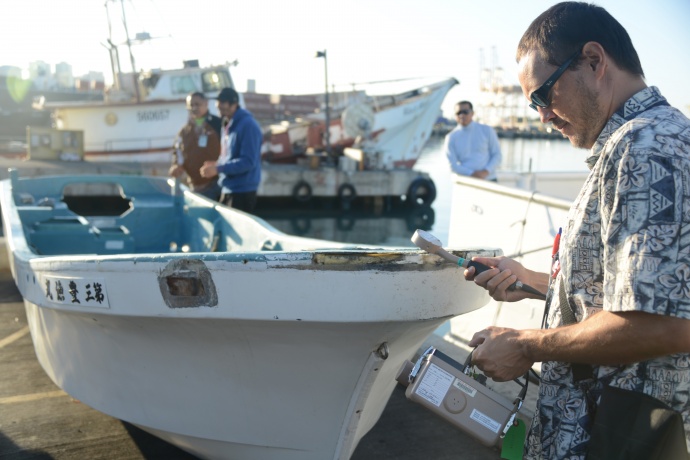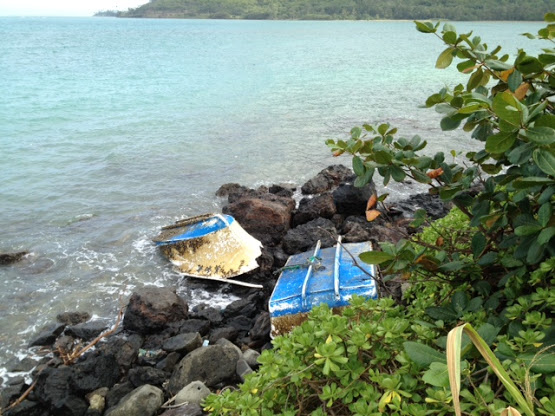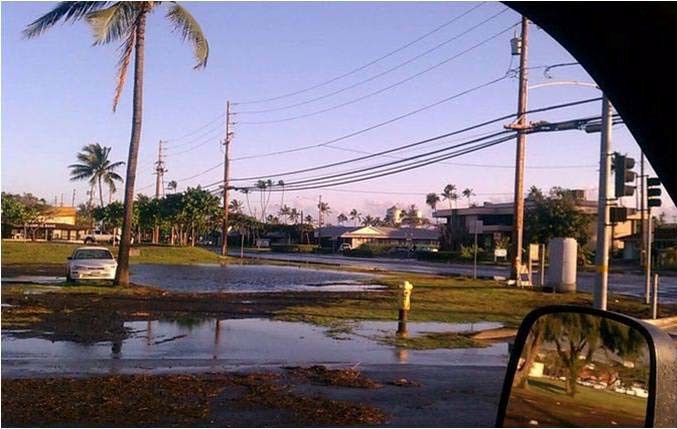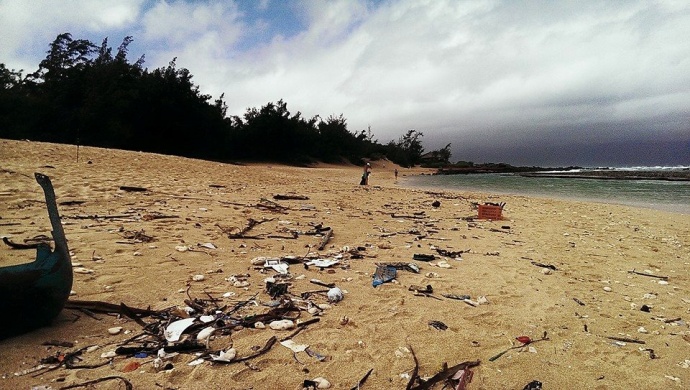Residents Urged to Continue to Report Marine Debris Sightings

Joshua Marvit, State of Hawaii Dept. of Health, tests a 16 foot skiff for radiation after the vessel was salvaged by the crew of the F/V Zephyr approximately 800 miles north of Honolulu, Oct. 5, 2012. The skiff was confirmed to have been debris from the 2011 Japan Tsunami by the Japanese Consulate, after they contacted the owners through the Japanese Ministry of Foreign Affairs, and confirmed that they did not seek its return. The Department of Land and Natural Resources and the State of Hawaii Department of Health conducted radiation tests and a search for invasive species as a precautionary measure. U.S. Coast Guard photo by Petty Officer 2nd Class Eric J. Chandler.
By Debra Lordan
A little over four years ago, on March 11, 2011, devastation struck Japan and affected the entire planet. Ongoing effects include debris in the Pacific Ocean, which reached adjacent shores as early as the end of 2011, and still continues to wash up on Hawaiʻi shores and elsewhere around the Pacific in 2015.
The earliest sighting of tsunami marine debris in Hawaiʻi was reported in August of 2012–a large buoy off Kilauea Point of Kauaʻi. Since then, numerous debris reports have come in from all of the Hawaiian Islands. The debris ranges in size from tiny plastic pieces to boats and a 60-foot-long dock–many of them encrusted with marine life. NOAA has officially confirmed 23 items that have been identified as Japanese tsunami marine debris, but the number may be higher.
The most recent sighting on Maui was reported to the local state Department of Land and Natural Resources office on Thursday, March 26. County Ocean Safely personnel described a large quantity of debris, including a Japanese market shopping basket, a plastic car bumper, many bits and pieces of colored plastic, and piles of knotted and twisted colored rope on Baldwin Beach.
DLNR Public Information Specialist Deborah Ward said a department officer assessed the debris, although much of it was cleaned up by beach-goers by the time the authority arrived.
Ward said none of the items–mostly little bits of plastic, beach-type debris, flotsam and jetsum–warranted further investigation.
“We take these incidents on a case-by-case basis,” Ward said. “We assess all reports, paying special attention to larger items such as boats, buoys and items with Japanese writing.”
It is not always possible to trace the items to their source, she said, adding that not all marine debris is from the Japanese tsunami.

Photo courtesy Hawaii News Now, used by permission, Dec. 2012. Boat in pieces on the rocky shore at Kahana Bay. Japanese characters are visible on the right bow.
The DLNR works with local nonprofits, county agencies and NOAA on everything from reporting to cleanup. The DLNR also communicates with the Japanese Consulate regarding large items identified as originating in Japan that the government may want returned.
“It is our protocol to do so,” said Ward. “We do it out of respect for the Japanese people.”
“We appreciate the reports, and also our residents’ willingness to help clean up the debris,” said Ward. “Please continue to report debris, especially large quantities, unusual items, large items and materials that may be hazardous.”
Of special concern are items that may have been at sea long enough to have become infested with marine hitchhikers–possibly invasive species.
“Debris from Japan’s tsunami qualifies as capable of harboring such species,” Ward said.
Reports can be made to the DLNR by calling (808) 587-0400 or via email.
The National Oceanic and Atmospheric Administration offers Marine Debris Handling Guidelines. NOAA recommends using common sense and following general safety guidelines. “If you don’t know what an item is, don’t touch it. If it appears hazardous, contact appropriate authorities.”
Marine items or significant accumulations of debris potentially related to the tsunami can also be reported to NOAA via and email. Include as much information as possible (location, date, time, with photos and any relevant descriptions).
Those interested in tracking the debris through a visual time sequence beginning on the day of the tsunami through today can use a model developed by the International Pacific Research Center at the University of Hawaiʻi at Mānoa. The model reflects factors in the movement of the oceans water, and the effects of wind.
More information is available on IPRC’s Marine and Tsunami Debris website.

Flooding in Kahului resulting from the 2011 Japan tsunami. Photo courtesy oceanjournal-sylvablogspot.com.
A Look Back (from various news sources)
The 2011 9.0 magnitude earthquake off the Pacific coast of Japan on Friday, March 11 (referred to in Japan as the Great East Japan Earthquake, the 2011 Tohoku earthquake or the 3.11 earthquake), was the most powerful earthquake ever recorded to have hit Japan, and the world’s fourth most powerful earthquake since modern record-keeping began in 1900.
The earthquake triggered powerful tsunami waves that reached heights of up to 133 feet, traveling up to six miles inland. The earthquake moved Honshu (the main island of Japan) 8 feet east and shifted the Earth on its axis an estimated four to 10 inches.
The Japanese National Police Agency confirmed 15,891 deaths, 6,152 injured and 2,584 people missing. People living away from home in temporary housing or due to permanent relocation numbered 228,863 .
A February 10, 2014 agency report listed 127,290 buildings totally collapsed, with a further 272,788 buildings ‘half collapsed’, and another 747,989 buildings partially damaged.
The tsunami caused level-7 meltdowns at three reactors in the Fukushima Daiichi Nuclear Power Plant complex, and the associated evacuation zones affecting hundreds of thousands of residents.
The World Bank estimated economic cost was $235 billion (US), making it the costliest natural disaster in world history.
LINKS









